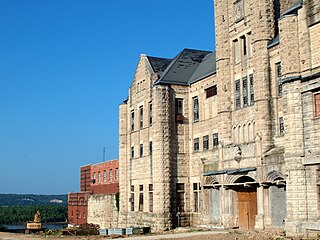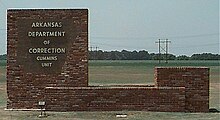
The Mississippi Department of Corrections (MDOC) is a state agency of Mississippi that operates prisons. It has its headquarters in Jackson. As of 2020 Burl Cain is the commissioner.
Capital punishment is a legal penalty in the U.S. state of Arkansas.

A prison farm is a large correctional facility where penal labor convicts are forced to work—legally or illegally—on a farm, usually for manual labor, largely in the open air, such as in agriculture, logging, quarrying, and mining. In the United States, such forced labor is made legal by the thirteenth amendment to the Constitution; however, some other parts of the world have made penal labor illegal. The concepts of prison farm and labor camp overlap, with the idea that the prisoners are forced to work. The historical equivalent on a very large scale was called a penal colony.

The Cummins Unit is an Arkansas Department of Corrections prison in unincorporated Lincoln County, Arkansas, United States, in the Arkansas Delta region. It is located along U.S. Route 65, near Grady, Gould, and Varner, 28 miles (45 km) south of Pine Bluff, and 60 miles (97 km) southeast of Little Rock.

Oregon State Penitentiary (OSP), also known as Oregon State Prison, is a maximum security prison in the northwest United States in Salem, Oregon. Originally opened in Portland 173 years ago in 1851, it relocated to Salem fifteen years later. The 2,242-capacity prison is the oldest in the state; the all-male facility is operated by the Oregon Department of Corrections (ODOC). OSP contains an intensive management wing, which is being transformed into a psychiatric facility for mentally ill prisoners throughout Oregon.

The Varner Unit is a high-security state prison for men of the Arkansas Department of Correction in Varner, Choctaw Township, unincorporated Lincoln County, Arkansas, United States. It is located along U.S. Highway 65, near Grady, and 28 miles (45 km) south of Pine Bluff. The prison can house over 1,600 prisoners, and it includes a 468-bed supermax facility. The supermax and non-supermax facilities are separate from one another.

Menard Correctional Center, known prior to 1970 as Southern Illinois Penitentiary, is an Illinois state prison located in the town of Chester in Randolph County, Illinois. It houses maximum-security and high-medium-security adult males. The average daily population as of 2007 was 3,410.

The Oklahoma State Penitentiary, nicknamed "Big Mac", is a prison of the Oklahoma Department of Corrections located in McAlester, Oklahoma, on 1,556 acres (6.30 km2). Opened in 1908 with 50 inmates in makeshift facilities, today the prison holds more than 750 male offenders, the vast majority of which are maximum-security inmates. They also hold many death row prisoners.
Thomas O. Murton was a penologist best known for his wardenship of the prison farms of Arkansas. In 1969, he published an account of the endemic corruption there which created a national scandal, and which was popularized in a fictional version by the film Brubaker.
The "trusty system" was a penitentiary system of discipline and security enforced in parts of the United States until the 1980s, in which designated inmates were given various privileges, abilities, and responsibilities not available to all inmates.

The Oklahoma Department of Corrections is an agency of the state of Oklahoma. DOC is responsible for the administration of the state prison system. It has its headquarters in Oklahoma City, across the street from the headquarters of the Oklahoma Department of Public Safety. The Board of Corrections are appointees: five members are appointed by the Governor; two members are appointed by the President Pro Tempore of the Senate; and two members are appointed by the Speaker of the house of Representatives. The board is responsible for setting the policies of the Department, approving the annual budget request, and working with the Director of Corrections on material matters of the agency. T. Hastings Siegfried is the current chairman of the board. The director, who serves at the pleasure of the governor, is the chief executive of the department. The current director of Corrections is Scott Crow, who was appointed after Director Joe Allbaugh resigned his post on June 13, 2019. Crow was confirmed by the Oklahoma State Senate as director in May 2020.

The Department of Public Safety and Corrections (DPS&C) is a state law enforcement agency responsible for the incarceration of inmates and management of facilities at state prisons within the state of Louisiana. The agency is headquartered in Baton Rouge. The agency comprises two major areas: Public Safety Services and Corrections Services. The secretary, who is appointed by the governor of Louisiana, serves as the department's chief executive officer. The Corrections Services deputy secretary, undersecretary, and assistant secretaries for the Office of Adult Services and the Office of Youth Development report directly to the secretary. Headquarters administration consists of centralized divisions that support the management and operations of the adult and juvenile institutions, adult and juvenile probation and parole district offices, and all other services provided by the department.

The Missouri State Penitentiary was a prison in Jefferson City, Missouri, that operated from 1836 to 2004. Part of the Missouri Department of Corrections, it served as the state of Missouri's primary maximum security institution. Before it closed, it was the oldest operating penal facility west of the Mississippi River. It was replaced by the Jefferson City Correctional Center, which opened on September 15, 2004.

The Tucker Unit is a prison in Dudley Lake Township, unincorporated Jefferson County, Arkansas, 25 miles (40 km) northeast of Pine Bluff. It is operated by the Arkansas Department of Correction (ADC). Tucker is one of the state of Arkansas's "parent units" for male prisoners; it serves as one of several units of initial assignment for processed male prisoners. It is in proximity to, but not within, the Tucker census-designated place.

Tucker is an Unincorporated community and census-designated place (CDP) in Jefferson County, Arkansas. It is located 30 miles (48 km) southeast of Little Rock. It was first listed as a CDP in the 2020 census with a population of 95.
Varner is an unincorporated community in Lincoln County, Arkansas, United States. Varner is located southeast of Little Rock.

Rufe Persful was an American criminal, convicted of murder, kidnapping and robbery. He was considered one of the most dangerous criminals of his era by the authorities.
Terrell Don Hutto, known as T. Don Hutto, was an American businessman and one of the three co-founders of Corrections Corporation of America (CCA), whose establishment marked the beginning of the private prison industry during the era of former President Ronald Reagan. In 1983, Hutto, Robert Crants and Tom Beasley formed CCA and received investments from Jack C. Massey, the founder of Hospital Corporation of America, Vanderbilt University, and the Tennessee Valley Authority. The T. Don Hutto Residential Center, one of CCA's detention centers, was named after him.

Barbara A. Ester Unit is a correctional facility of the Arkansas Department of Correction (ADC), located in Pine Bluff, Arkansas. It is scheduled to have a capacity of 580 prisoners, and it is the first prison in the ADC dedicated to the re-entry of prisoners into society. In addition to prisoners who are to be released within six months, it also houses prisoners who were incarcerated due to disobeying the rules of their parole. The prison's namesake is Barbara Ester, a prison guard holding the rank corporal at the East Arkansas Unit. She died on January 20, 2012, at the hands of a prisoner.
Hutto v. Finney, 437 U.S. 678 (1978), is a landmark Supreme Court case against the Arkansas Department of Correction. The litigation lasted almost a decade, from 1969 through 1978. It was the first successful lawsuit filed by an inmate against a correctional institution. The case also clarified the Arkansas prison system's unacceptable punitive measures. Hutto v. Finney was a certiorari to the United States Court of Appeals for the Eighth Circuit.


















